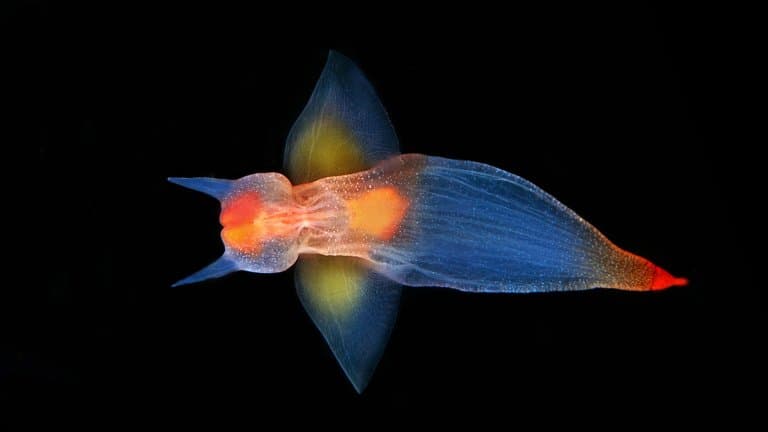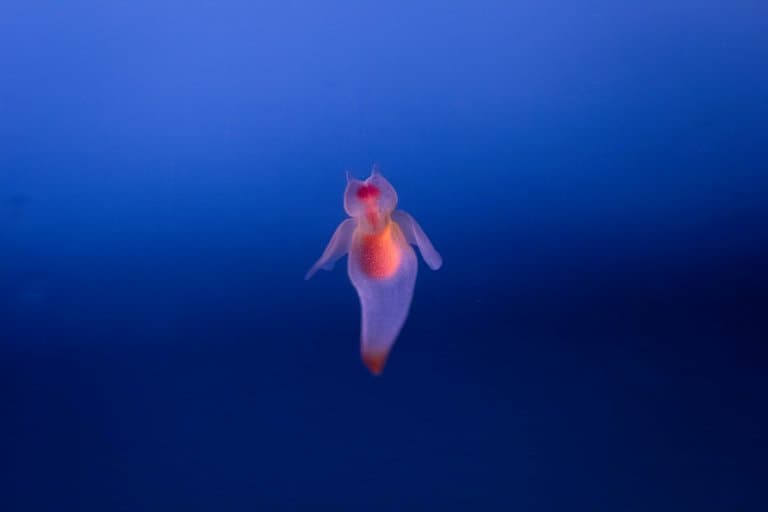Sea Angel Profile
Angels are everywhere in religious texts. In the Quran, God has a bunch of Yes Men, or Cherubs, who are tasked with following him around and stroking his ego. In Christianity, Cherubs are the Angelic bearers of wisdom and sit beneath the seraphim as the second-highest order of angels.
In contemporary depictions, they’re fat little boys who interfere with people’s love lives, and in Jewish lore, they’re way down near the bottom of the angel ranks, sweeping up stardust from celestial office parties and refilling the magic printer paper.
But sea angels most closely resemble the description by Ezekiel, of an angel who, while created by God, apparently was left with a backdoor for sin to enter and was hurriedly cancelled.
Sea angels are over 3,000 species of free-swimming slugs from 6 different families that live worldwide, in both icy and tropical waters.

Sea Angel Facts Overview
| Habitat: | Oceanic, all waters |
| Location: | Worldwide |
| Lifespan: | Unknown |
| Size: | Some species reaching up to 7 cm (2.8 inches) |
| Weight: | Not recorded |
| Colour: | Transparent, with colourful internal organs, yellows, reds, greens. |
| Diet: | Sea butterflies |
| Predators: | Filter feeders |
| Top Speed: | Not specified |
| No. of Species: | 3,000+ |
| Conservation Status: | Not listed |
Sea angels are ancient gastropods, related to slugs and snails.
They’ve been found in fossils that date back as far as 400 million years, and over that time have become far from angelic.
These toxic butterfly-killers are specialised predators in a tiny world, and despite their small size, are a critical part of the enormous foundation of our global ecosystems.
Interesting Sea Angel Facts
1. They’re slugs
Sea angels are a collection of sea slugs whose ‘foot’ has evolved to splay out like wings. They’re in the Gastropoda class of molluscs, along with the familiar garden snails and slugs you’ve probably murdered with salt for eating your lettuces.
The difference is, while the garden pests use a foot to wetly slug themselves around your allotment, in sea angels, this foot has expanded into wings, giving them the name for their order: Pteropoda (wing-foot).
And these are some attractive slugs. They spend their days looking pretty, flapping their way through the water in search of butterflies.

2. Angels and butterflies
Sea butterflies are a similar group of animals, and they also have some very appealing wing-like appendages.
But this group usually has a shell, where none is present in sea angels.
This tiny shell may not look like much, but it’s said that between them, sea butterflies sequester 500 billion tons of carbon into them!
But enough about them, let’s get back to the angels.
3. They’re not very angelic
According to Ezekiel, the most beautiful angel ever created was eventually condemned: “By the abundance of your trade you were internally filled with violence” – God, probably.
This is how Lucifer was banned from the club and ultimately spent his days slowly killing butterflies with his spiny tongue and flapping about in the lower levels.
Sea angels, similarly, live under the ocean surface, mostly killing sea butterflies. They can both ambush and chase their prey, and have special predatory hooks to snare them with.
They’re generally slow-moving but can flap with significant urgency, using a special set of fast-moving wing muscles, to move with surprising speed when necessary.
Once caught, a toothed radula, like a snail’s tongue, presents extendable, serrated teeth that are prehensile, and scrape their prey to death.
This relationship with sea butterflies has been so consistent for so many millennia, that sea angels have evolved to specialise in predation of sea butterflies, and are well equipped to do so.
This is a little divergent from the harps and feathers from familiar legends. 1
4. They’re also toxic
This isn’t just a comment on their attitudes, it’s also a biochemical fact. Sea angels taste like crap, and as such, they have no known predators (other than filter feeders, who will pretty much eat anything that enters their mouths).
What’s particularly interesting about the toxins secreted by sea angels is that they make it themselves.
Many animals gather up plant or animal defences from their food to make them unappetising to their predators. Poison dart frogs collect batrachotoxin from the beetles they eat. Toxic sea slugs like Pleurobranchaea maculata store and secrete tetrodotoxin from the food they eat.
Even humans gather plant defenses like caffeine and tannin from coffee and tea and this makes them inedible to killer whales and (most) sharks.
But sea angels have their own recipe for chemical defences, and this is highly unusual. In fact, in the entire community of pelagic gastropods (slugs and snails), they’re the only ones known to do so. 2
5. This has not gone unnoticed
Ironically, this defence does draw some unwanted attention from tiny crustaceans called amphipods.
These opportunistic kidnappers recognise the value of the sea angel’s protective shield and capitalise on it for their own safety. There’s no discernible benefit to the sea angel of this relationship, and it just sits there, trapped, until it starves to death.
The amphipod, on the other hand, gets a morbid decoration for its shell and the foul taste of fallen angel to put off its fishy predators. 3
6. They’re not all pretty
The classic visage of a sea angel is the elegant, horned creature with beating wings and a translucent body showing stunningly colourful internal organs and really living up to the name.
But they’re not all like that. Some of them, like certain members of the Canidae family, look a bit like a jellyfish that’s been hit by a car.
Many go through significant changes in their lives, morphing from one form to another, so are ugly for a while before becoming much more presentable later in life. 4
7. They’re protandrous hermaphrodites
Angels are notoriously disappointing in the bedroom on account of their Ken-doll-like, pelvic insufficiency.
In contrast, Sea Angels not only have infinitely more genitalia than a real angel but twice that of most sexually reproductive animals.
Hermaphroditic animals are fascinating already, but animals that transition between sexes as they mature are even weirder.
Sea angels begin life as males and grow female sex organs as they age. And the community doesn’t stigmatise them for it, either. Mature sea angels have both male and female dangly bits and can fertilise themselves internally.
But this is only one metamorphosis of many that this biblical sea slug experiences in its lifetime.
8. They have an incredible mating ritual
Sea angels will extend their reproductive organs, and attach themselves to one another. They can mate for up to four hours, and even carry on eating prey while still attached.
9. They begin with shells
Sea angels begin as sea snails, being born with their embryonic shells. But these are quickly shed as they grow, which sets them apart from their closely related prey.
Because of this, ocean acidification threatens both groups.
10. They’re critical to the trophic web
As the ocean warms, it becomes more layered. These strata are harder to mix, and without a regular infusion of carbonate-rich water from the depths, the surface strata become saturated with carbon dioxide.
On top of this, increases in CO2 in the atmosphere lead to more absorption of this acidic gas into the oceans, lowering the pH of the water.
Animals like sea butterflies rely on calcium carbonate for their shells, and in an increasingly acidic environment, the molecular bonds of this chalk start to dissolve. If they are unable to make their shells, they will die, and this not only removes the carbon sequestration from the environment but also a significant portion of the available food for the rest of the ocean, including sea angels.
The cascade of effects from this should be obvious; large filter feeders like whales, whale sharks, and basking sharks, run out of food. Their nitrogenous waste is removed from the equation, and algae have less to feed on, so proliferate less.
Less algae reduce food for animals like the sea butterfly, compounding the problem in a negative feedback loop. When ocean ecosystems collapse, our entire existence is also threatened. Marine organisms produce the majority of our oxygen. 5
Sea Angel Fact-File Summary
Scientific Classification
| Kingdom: | Animalia |
| Phylum: | Mollusca |
| Class: | Gastropoda |
| Order: | Pteropoda |
| Superfamily: | Clionoidea & Hydromyloidea |
| Family: | Clionidae Cliopsidae Notobranchaeidae Pneumodermatidae Hydromyloidea Hydromylidae Laginiopsidae |
Fact Sources & References
- J.E.Morton (1958), “Observations on the gymnosomatous pteropod Clione limacina”, Plymouth Marine Science Electronic Archive (PlyMSEA).
- P. J. Bryan (1995), “Ecological role for pteroenone, a novel antifeedant from the conspicuous antarctic pteropod Clione antarctica (Gymnosomata: Gastropoda)”, Springer Link.
- (2018), “‘Kidnapping’ in the Antarctic animal world? A puzzling relationship between amphipods and pteropods”, Science Daily.
- “Clionidae”, Shutterstock.
- “How has the ocean made life on land possible?”, ocean exploration.
